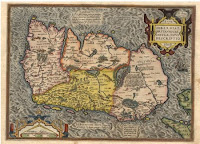What then is time? If no one asks me, I know: if I wish to explain it to
one that asketh, I know not: yet I say boldly that I know, that if
nothing passed away, time past were not; and if nothing were coming, a
time to come were not; and if nothing were, time present were not. Those
two times then, past and to come, how are they, seeing the past now is
not, and that to come is not yet? But the present, should it always be
present, and never pass into time past, verily it should not be time,
but eternity.
With this passage, found halfway through Book XI of his
Confessions, St. Augustine of Hippo (13 November 354-28 August 430) discussed the difference between Time and Eternity. He knows that he is not aware of time that is yet to come, or time that is past; only time that is present; but he still doesn't know how to define what time
is.
 |
| A medieval 24-hour clock. |
Measurement of time was imprecise. There were "hours" of the day: the Vigil took place between 2:30 and 3:00 a.m., Matins came at Dawn,
et cetera. These hours designated times of worship and work for monks and were extended to general use, but they were not exactly a way to quantify time. The hour of Sext was at noon, for instance, which was recognized when the sun was highest, but Matins/Dawn came more or fewer hours before Sext, depending on the time of year. They were segments of the day that altered with the seasons; they did not
measure a span of time.
St. Benedict of Nursia (c.480-543), in his
Rule for monks, intends them to worship at specific times, and finds a way to measure a span of time. Monks were not to slack at getting up for Matins, and so:
If anyone shall come to matins after the Gloria of the 94th Psalm, which on this account we wish to be said slowly and leisurely, he shall not take his place in the choir, but go last of all, or to some place apart which the abbot may appoint for those who so fail in his sight.
Time could be measured, therefore, by comparison to a known duration.* But even durations could be tricky. Augustine had pondered thinking of a long syllable as equivalent to two short ones, "But when two syllables sound one after the other—the first short, the second long—how shall I keep hold of the short one?" Augustine seemed to be caught up in the idea that time was a continuum, and that he was living in a constant present and could not treat the past and future in the same conceptual way, since he could not live in them. The Middle Ages couldn't grab time and measure it, like water or distance or even acceleration. It was insubstantial, and belonged to God.
The concept of time had to change ... and eventually it did. There was no clear turning point; there had to be some conceptual change, planned or otherwise, to see time not as a line but as a series of points, as separate moments that could be thought of without being linked to a past or future moment.
Sometime in the mid-13th century, we find Franco of Cologne. He was a music theorist who gave us
the idea that a mark on a page should distinguish how long a note should
be. This was the logical extension of Franco's definition of time: "Time is
the measure of actual sound as well as of the opposite, its omission."
Was this the moment? Was it music, with its attention to and reverence for mathematics that accidentally inspired the thinking of time as separate units that could be measured and counted? We might be able to believe that, if there were some evidence that the world began to measure and quantify time; for instance, if the development of mechanical clocks were to start around this time.
Well, guess what happened next?
*
This method of measuring spans of time without a clock is used even today.



























